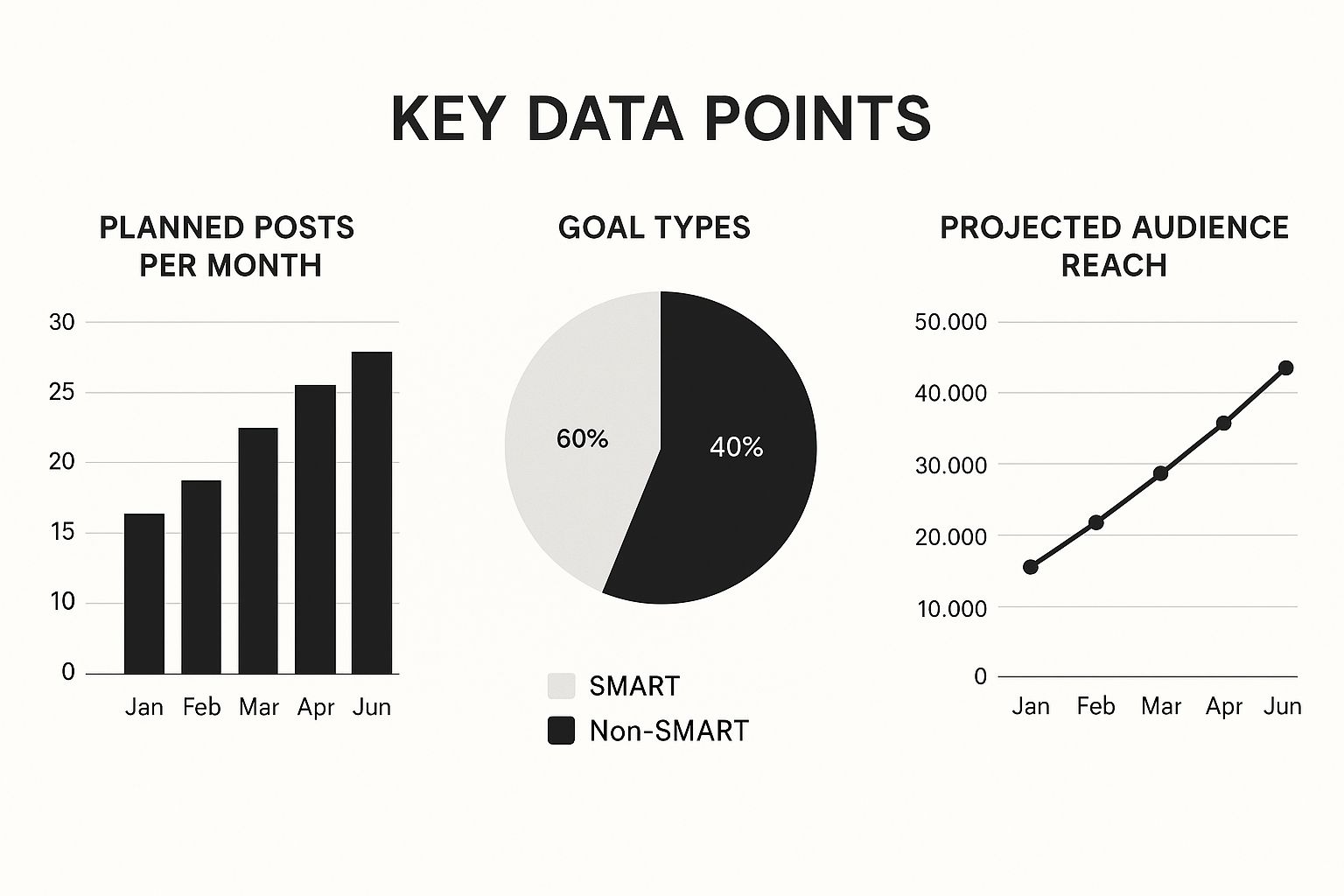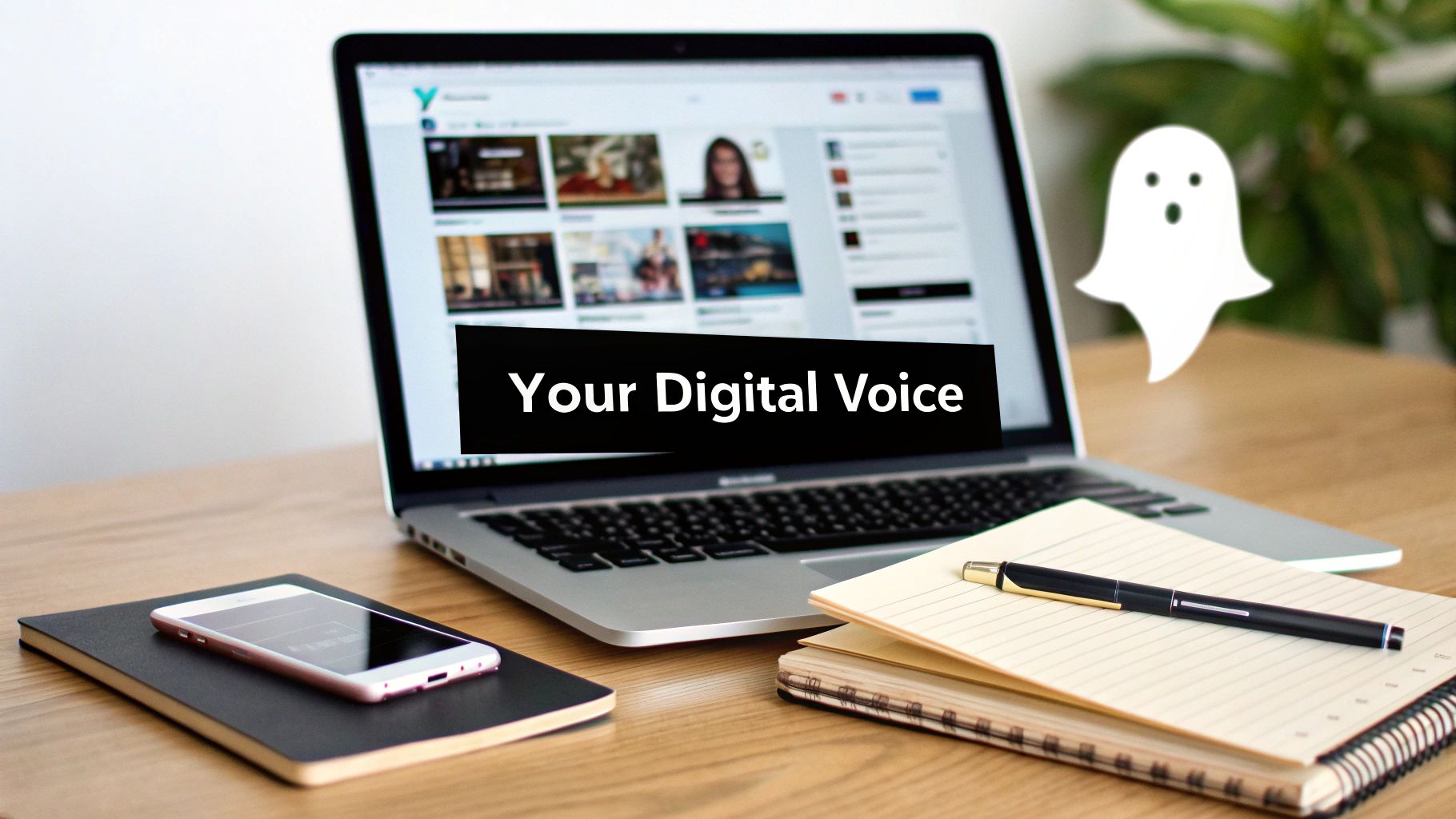Before you even think about what to post, you need a solid game plan. Effective social media planning isn't just about scheduling content; it’s the strategic blueprint that ensures every single post, every campaign, and every interaction has a clear purpose. This is how you shift from simply being active online to driving real, measurable business results.
Setting the Foundation for Your German Social Media Plan

To succeed, especially in the distinct German market, your social media plan needs to be built on a strong foundation of clear goals and a frank self-assessment. This is where you move past guesswork and start defining what success actually means for your brand. To get this right, it's worth understanding the essential elements of an effective social media strategy.
Every objective you set should tie directly back to a larger business outcome, whether that's driving more traffic to your website, generating qualified leads for your sales team, or building genuine customer loyalty.
Define Your SMART Goals
Saying you want "more followers" is a wish, not a strategy. To get serious, your objectives must be SMART: Specific, Measurable, Achievable, Relevant, and Time-bound. This simple framework turns vague ideas into concrete targets.
Let's break it down with some real-world examples:
- Specific: Don't just aim for "more engagement." A specific goal is to "increase the average comment rate on our Instagram posts by 15%."
- Measurable: Pinpoint the exact metric. Instead of "grow our LinkedIn," try "grow our LinkedIn follower count from 500 to 1,500."
- Achievable: Be realistic. Doubling your entire following in a week is probably a fantasy. A 20% increase over the next quarter? That’s much more grounded.
- Relevant: How does this goal help the business? If the company’s priority is sales, a relevant social media goal is to "generate 50 qualified leads through our Facebook Ads campaign."
- Time-bound: Every goal needs a deadline. For instance, "achieve our lead generation target by the end of Q3."
A plan without clear, measurable goals is just a wish list. By applying the SMART framework, you create a roadmap that gives every piece of content a distinct purpose and makes it possible to track your return on investment.
Conduct a Social Media Audit
With your goals in place, it’s time to take an honest look in the mirror. A social media audit is your chance to figure out what's working, what’s falling flat, and where your biggest opportunities lie.
Dive into each of your platforms and start asking some tough questions:
- Which specific posts earned the most likes, comments, and shares? Why?
- What’s our current follower growth rate, and is it trending up or down?
- Are our profiles fully optimised and consistently branded across all channels?
- Who is actually engaging with our content? What does our audience demographic look like?
This process uncovers incredibly valuable patterns. You might discover that your German audience loves your behind-the-scenes video content but completely ignores text-only updates.
These insights are particularly critical in Germany, where users can be more discerning. While an impressive 93% of German adults are online, only about 51% actively use platforms like Facebook or Instagram. This creates a significant 42-point gap between general internet use and social media activity, meaning you have to work smarter to capture attention. Getting a handle on these data-driven insights is the only way to build a strategy that delivers real, tangible results.
Understanding Your German Audience's Online Behaviour
To truly connect with a German audience, you have to go deeper than simple translation. It’s about understanding their specific digital culture and online habits. Let’s be honest, just knowing basic demographics won't get you very far. The real magic happens when you can paint a detailed picture of your ideal customer—what makes them tick, where they hang out online, and what they actually care about.
Think about it: the Gen Z user endlessly scrolling TikTok in a Berlin café is worlds away from the B2B decision-maker scanning their LinkedIn feed in Frankfurt. Each has a completely different mindset, unique motivations, and a distinct taste in content. Creating detailed user personas is your way of stepping into their shoes to build a strategy that genuinely hits home.
Crafting Your German User Personas
A user persona is essentially a character sketch of your ideal customer, built from real data and research. Instead of vaguely targeting a "30-year-old from Munich," you create "Klaus." He’s a 32-year-old project manager who relies on LinkedIn for hard data and industry news but unwinds by following niche woodworking accounts on Instagram over the weekend. See the difference?
So, how do you build these personas? Start digging for data:
- Check your current followers: Dive into your native platform analytics. Who’s already following and engaging with you? Look at their age, location, and gender to find initial patterns.
- Talk to your customers: Send out a quick survey to your email list. Ask them which social media platforms they use every day and what kind of content they find genuinely useful.
- Listen to the conversation: Use social listening tools to monitor discussions around your brand and industry. What are people’s biggest frustrations? What kind of language do they use? This is gold.
A well-crafted persona is more than just a list of stats. It's a story about your ideal customer—their goals, their challenges, and what truly motivates them. This story becomes the compass for your entire content strategy.
This detailed groundwork helps you visualise the entire plan, from how many posts you'll create to the specific goals you're trying to hit. It's about mapping out your path to success.

As this shows, tracking your planned posts, defining clear goals, and projecting your reach gives you a tangible way to measure what's working over time.
Tapping into Competitor Insights
Your competitors are sitting on a treasure trove of audience data—and you can learn a lot from it. A quick analysis of their social media presence will show you what’s already working with your shared audience and, more importantly, where the gaps are.
Look at their best-performing posts. Are short-form videos getting all the love? Do question-based captions kick off a great debate in the comments? These aren't just random observations; they are direct clues for your own content planning.
Understanding the broader demographic trends in Germany is also a game-changer. Social media usage varies massively by age. Young adults (16-29 years old) are almost universally online (100% adoption), living on platforms like TikTok and Instagram. The 30-49 age group is also highly active at around 85% engagement, often preferring Facebook and WhatsApp. Meanwhile, over 70% of 50-64 year-olds tend to stick with Facebook to stay in touch with friends and family. You can learn more about German internet usage to see how these behaviours play out.
This table breaks down the preferred social media platforms and content types for key demographic segments in Germany, helping you choose the right channels for your strategy.
German Social Media Platform Usage by Age Group
| Age Group | Primary Platforms | Preferred Content Format | Engagement Behaviour |
|---|---|---|---|
| 16-29 | TikTok, Instagram, YouTube | Short-form video (Reels, Shorts), authentic Stories, user-generated content | High engagement, trend-driven, values authenticity and entertainment |
| 30-49 | Facebook, LinkedIn, Instagram | Informative articles, high-quality images, video tutorials, product reviews | Seeks value and information, engages with brands that solve a problem |
| 50-64 | Facebook, WhatsApp | Family/friend updates, news articles, community group posts, nostalgic content | Prefers familiar networks, values connection, less likely to follow new trends |
Using this kind of data ensures you aren't just shouting into the void. You're focusing your time, energy, and budget exactly where your audience is most likely to listen.
Choosing the Right Platforms and Content Strategy

Trying to be everywhere on social media is a classic mistake, and it's a surefire way to burn through your resources, especially in a market as specific as Germany. The key isn't to have a profile on every platform; it's to be active on the right ones. This decision shouldn't be about chasing the latest trend, but about a smart, strategic choice that reflects who your brand is and where your audience actually hangs out.
Every platform has its own unwritten rules and distinct culture. LinkedIn is the go-to for professional networking and B2B discussions. TikTok is all about fast, creative, and entertaining videos. Instagram is a visual playground, perfect for brands with a strong aesthetic or physical products. Your brand's voice has to genuinely fit the vibe of the platform, otherwise, you'll just come across as inauthentic. We've got more practical advice on this in our guide to succeeding with online marketing for Instagram.
Matching Your Brand to the Right Channel
So, how do you pick? It starts with asking some honest questions about your brand and your customers. This simple exercise will help you focus your efforts where they'll make a real difference.
- Where is your audience? Go back to those customer personas you created. If you're selling to B2B decision-makers, you absolutely need to be on LinkedIn. It's not optional.
- What content can you actually create well? Be realistic. If your product looks incredible, Instagram is a no-brainer. But if your expertise lies in detailed analysis, maybe a company blog promoted through LinkedIn makes more sense.
- What's your brand's personality? Are you witty and a bit informal, or are you more of an authoritative, educational voice? A playful brand might kill it on TikTok, whereas a serious financial firm would probably feel out of place.
Building Your Content Pillars
Once you've zeroed in on your primary platforms, it's time to define your content pillars. Think of these as the main themes or topics you’ll consistently talk about. They are the foundation of your entire content library.
Content pillars are what give your feed a clear, cohesive story, preventing it from becoming just a random jumble of posts. For example, a fitness brand's pillars might be:
- Workout Tutorials
- Healthy Recipes
- Motivational Mindset Tips
These pillars aren't just for organising your calendar—they're for building authority. When you consistently deliver valuable content around a few core topics, you position your brand as the go-to expert in that niche. That's how you build real trust over time.
This focused approach is crucial when you consider the sheer scale of social media in Germany. There are over 67.8 million active users here—that's more than 80% of the population. But with the average person juggling 5.4 different social media accounts, your content has to be incredibly relevant to get noticed.
Understanding these numbers helps you see why a scattered, "spray and pray" approach just doesn't work. By carefully aligning your platforms with your content pillars, you create a sharp, focused strategy that speaks directly to the people you want to reach.
Building a Practical and Agile Content Calendar

Let’s be honest, a content calendar is where your big social media ideas actually become reality. It’s the bridge between your ambitious goals and what you’re actually going to post on Tuesday at 10 AM. Without one, you’re just winging it, which usually leads to panicked, last-minute posts and a whole lot of missed chances.
But a great calendar isn't just a to-do list with dates. Think of it as your team's command centre. You can start with a simple spreadsheet or go all-in with a dedicated social media tool, but the goal is the same: get all the crucial details organised in one place.
Key Components of a Strong Calendar
To get the most out of your calendar, you need to track a few core details for every single post. This isn't about creating busywork; it's about eliminating confusion and making your process smooth, especially when you’re working with a team.
Here's what I recommend tracking for each piece of content:
- Platform: Where is this going? Instagram, LinkedIn, TikTok? Be specific.
- Date and Time: The exact moment you plan to hit ‘publish’.
- Content Format: Is it a single image, a video Reel, a carousel, a poll, or just a text update?
- Visuals: A direct link to the final image or video file. No more "where's that graphic?" messages.
- Copy: The final, proofread caption.
- Hashtags: Your researched and ready-to-go list.
- Links and CTAs: The URL you're driving traffic to and the specific call-to-action you're using.
Getting started can feel daunting, so looking at some established content calendar templates can give you a fantastic head start on structuring your own.
The best social media calendars are not rigid schedules set in stone. They are living documents designed with agility in mind, providing structure while leaving room for spontaneity and real-time relevance.
Balancing Structure with Agility
Consistency is king, but the real magic of social media is in its immediacy. If your calendar is planned down to the minute for the next three months, your brand can come across as stiff and out of touch. You have to build in some wiggle room from day one.
What does that look like? It means intentionally leaving some empty slots in your schedule. These are your golden opportunities to react to breaking industry news, hop on a trending meme that actually fits your brand, or share some amazing user-generated content that just landed in your DMs.
It’s this mix of planned-out, value-driven posts and of-the-moment spontaneous content that makes a brand feel human and authentic.
Your aim is to establish a reliable rhythm while keeping yourself nimble enough to jump on the conversations people are having right now. For a deeper look at building a strategy that connects, check out our complete guide on developing a powerful social media content strategy. When you strike this balance, your calendar stops being a restrictive schedule and becomes a powerful tool that helps you seize the moments that truly matter.
Measuring Performance to Refine Your Strategy
A social media plan isn't something you can just set and forget. Think of it as a living document, one that needs to breathe and adapt based on real-world data. Honestly, creating great content is only half the battle. If you really want your social media planning to pay off, you have to get into a rhythm of tracking, analysing, and tweaking your performance.
This feedback loop is your secret weapon for getting better over time. It’s how you stop guessing what your audience wants and start knowing.
Identifying the KPIs That Truly Matter
It’s so easy to get distracted by vanity metrics. You know the ones—follower counts, total likes—they look impressive on a report but don't actually tell you much about your business impact. Sure, a big follower number feels good, but it's not worth much if none of those people are engaging with what you post or, better yet, becoming customers.
Your focus needs to shift to Key Performance Indicators (KPIs) that are tied directly back to those SMART goals you set earlier. These are the numbers that tell the real story.
Here are a few of the big ones you should be watching:
- Engagement Rate: This is all about how involved your audience is. We're talking likes, comments, shares, and saves, usually calculated as a percentage of your followers or reach. A healthy engagement rate is a fantastic sign that your content is genuinely resonating.
- Reach and Impressions: What’s the difference? Reach tells you how many unique people saw your content. Impressions tell you the total number of times it was seen (one person could see it multiple times). Tracking both gives you a clear picture of your brand's visibility.
- Conversion Rate: This is where the rubber meets the road. It’s the percentage of people who take a specific action you want them to, whether that’s clicking a link, signing up for your newsletter, or buying a product. It's one of the clearest ways to measure your return on investment (ROI).
An effective social media strategy is built on meaningful data, not just follower numbers. Prioritising metrics like engagement, reach, and conversions gives you the insight needed to make smart, data-backed decisions that drive real business growth.
If you want to go deeper on this, we've put together a full guide on choosing the right social media KPIs for your business goals.
Leveraging Analytics Tools
You don't need a massive budget to get started with performance tracking. In fact, every major social media platform gives you a free, built-in analytics dashboard packed with useful information.
Take Instagram Insights, for example. It shows you exactly how your posts are performing, gives you a breakdown of your audience demographics, and even tells you the best times to post based on when your followers are most active. For B2B brands, LinkedIn Analytics is a goldmine, offering detailed data on your page visitors and content engagement.
As you scale up, you might want to look into third-party tools. These can pull all your data from every channel into one clean dashboard. They often come with more advanced features, too, like competitor analysis and custom reports that can save you a ton of time and uncover deeper insights.
Turning Insights Into Action
Here’s the most important part: data is useless until you do something with it. The real magic happens when you interpret what the numbers are telling you and use those insights to make your strategy better. By checking your analytics regularly, you'll start to spot patterns.
For instance, maybe you notice that a series of behind-the-scenes videos got 30% higher engagement than your standard product photos. That’s a huge clue! It's the market telling you to create more of that kind of content. Or perhaps you see that your reach is always highest on posts that go live on Wednesday mornings. Easy—adjust your calendar to match.
This constant cycle of testing, measuring, and refining is what takes a social media plan from just "good" to truly great.
Common Questions About Social Media in Germany
Diving into the German social media market often brings up a few specific hurdles. To build a solid plan, you need to get your head around these nuances. So, let's walk through some of the most common questions I hear and give you some straightforward, practical answers.
How Often Should I Post on Each Platform?
This is the million-dollar question, isn't it? The truth is, there's no single magic number. The key is to aim for consistency over just flooding your followers' feeds. German audiences tend to appreciate quality over sheer quantity, so one thoughtful post will always beat five rushed ones.
As a starting point, here are some solid benchmarks I've seen work well:
- LinkedIn: Aim for 2-4 times per week. This is your space for high-value professional content—think industry insights, company news, and expert articles.
- Instagram: Try 3-5 times per week for your main feed. You'll want to back this up with daily Stories to keep your audience engaged and give them a peek behind the curtain.
- Facebook: A good rhythm is 3-5 times per week. The algorithm can be a bit of a moving target, so it’s smart to experiment with videos, polls, and links to see what really connects with your audience.
- TikTok: This platform loves fresh content, so 4-6 times a week, or even daily, is a great goal if you can keep the quality high.
The best posting frequency is whatever you can realistically maintain without your quality dipping. Use these numbers as your launchpad, then dig into your analytics. See when your audience is online and engaging, and then tweak your schedule from there.
What Are the Best Free Tools for Social Media Planning?
You absolutely don't need a massive budget to get your social media organised. There are some fantastic free tools out there that can help you get your workflow in order and your content calendar sorted.
A great place to start is with the platforms themselves. For example, Meta Business Suite lets you schedule and plan everything for both Facebook and Instagram from one dashboard. For small businesses just starting out, it’s often more than enough.
If you're juggling a few more accounts and need a bit more power, check out tools like Hootsuite or Buffer. Their free plans are surprisingly robust, letting you manage multiple profiles, schedule posts well in advance, and see your entire publishing calendar at a glance.
How Do I Handle Regional Differences Within Germany?
This is a really smart question. Germany isn't a monolith; it's a country with massive regional differences in culture, dialects, and what people care about. While a single national strategy can work, weaving in some of these regional flavours can make your brand feel far more authentic and connected.
For instance, a campaign in Bavaria could cleverly reference local traditions like Oktoberfest, while one targeting Hamburg might lean into its famous maritime history. This doesn't mean you need to build entirely separate strategies for each region—that would be a nightmare.
Instead, think about small, meaningful tweaks. Use location-specific hashtags, give a shout-out to local events, or run targeted ads that speak directly to users in different states (Bundesländer). The best way to get this right is to listen. Pay attention to the local conversations happening online and you’ll pick up on the subtle cultural cues you can weave into your posts. It shows you've done your homework and respect the local culture, which is a powerful way to build brand loyalty.
Ready to make your social media planning effortless? Trustypost is your AI-powered partner for creating consistent, on-brand content. Get daily post ideas tailored to your voice, schedule content across all your platforms, and turn your online presence into a lead-generating machine. Start your free trial at https://trustypost.ai and see the difference.



